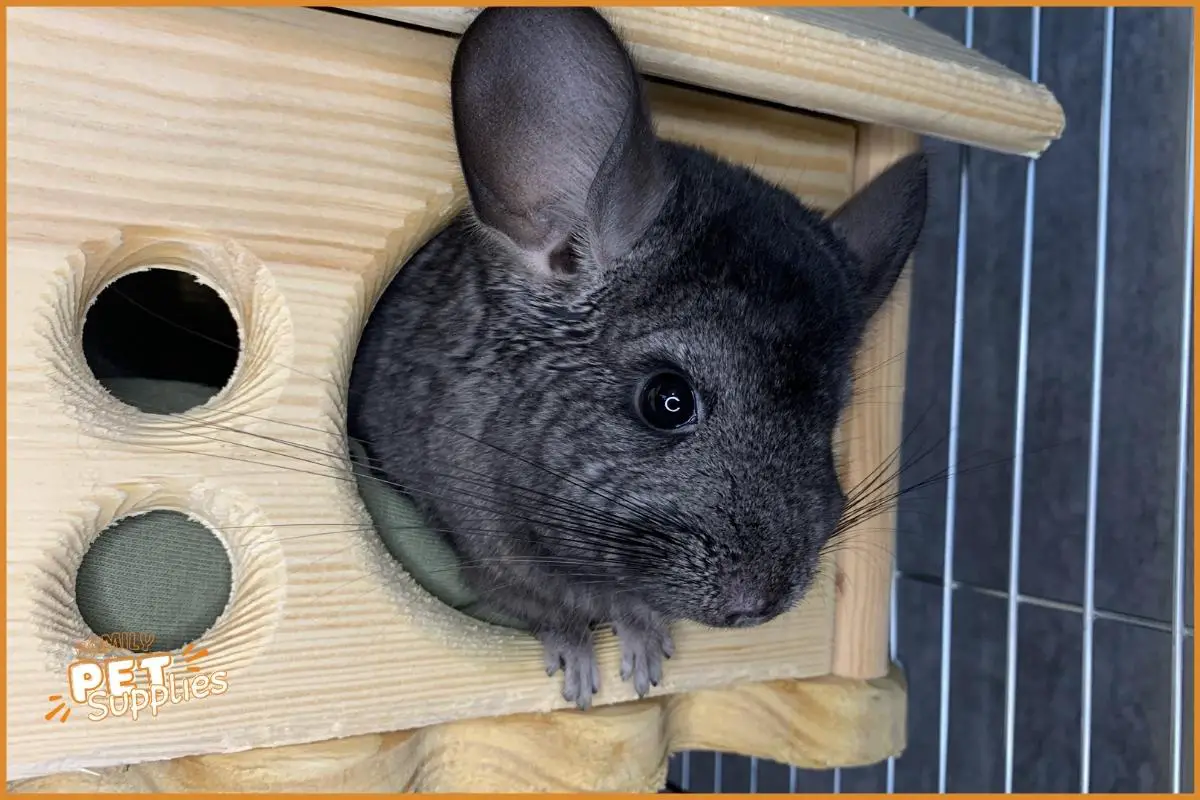Chinchillas are naturally active and curious animals. In the wild, they forage for food, interact socially, and evade predators. In captivity, they enjoy climbing, playing with toys, and taking dust baths. Regular interaction and a stimulating environment are essential for their mental and physical health.

Key Takeaways
- Chinchillas engage in foraging for food and have a herbivorous diet consisting of grasses, herbs, leaves, bark, and twigs.
- They socialize with other chinchillas and use vocalizations and body language to communicate.
- Chinchillas have unique grooming habits, using their front paws and special teeth called incisors to keep their coats clean.
- Chinchillas are playful animals and enjoy engaging with toys, climbing, exploring, and taking regular dust baths for their hygiene.
Natural Behaviors
Chinchillas engage in a variety of natural behaviors, such as foraging for food, socializing with others, and evading potential predators. These small, furry creatures have unique grooming habits that help keep their coats clean and healthy.
Chinchillas use their front paws to groom themselves, often licking their fur to remove dirt and debris. They also have special teeth called incisors that grow continuously, allowing them to chew and clean their fur.
As for sleep patterns, chinchillas are crepuscular animals, meaning they’re most active during dawn and dusk. They typically sleep for short periods throughout the day and night, taking quick naps to recharge their energy.
Foraging and Feeding Habits
To understand the foraging and feeding habits of chinchillas, you need to know what they typically consume in their natural habitat. Chinchillas are herbivores and have specific food preferences. Their diet consists mainly of grasses, herbs, and leaves. They also enjoy eating bark, twigs, and small plants.
Chinchillas have developed unique foraging techniques to find their food. They’re agile climbers and can reach high branches to access their preferred food sources. They also use their strong teeth to gnaw on bark and twigs.
Chinchillas have a sensitive digestive system, so it’s important to provide them with a balanced diet in captivity. Pellets made specifically for chinchillas, along with hay and fresh vegetables, should be included in their diet to ensure they receive the necessary nutrients.
Social Interactions
When interacting with chinchillas, it’s important for you to understand their social behaviors. Chinchillas are highly social animals and use various forms of communication to interact with each other. They make vocalizations such as chirps, squeaks, and barks to express their emotions and intentions. They also use body language, such as ear position and tail movements, to communicate.
Bonding with humans is possible but requires patience and trust-building. Spending time with your chinchilla every day, offering treats, and gentle handling can help establish a bond. It’s important to remember that chinchillas are prey animals, so they may be initially cautious.
Predator Evasion Techniques
Stay alert for potential threats and utilize your agility to swiftly evade predators.
Chinchillas have developed various predator evasion techniques to increase their chances of survival in the wild. One technique they use is camouflage. Their fur, which comes in various shades of gray, helps them blend into their surroundings, making them difficult for predators to spot.
Chinchillas also rely on their excellent jumping and climbing abilities to escape danger. They can quickly dart up trees or scale rocky terrain to reach hiding spots where predators can’t reach them. These hiding spots can include crevices in rocks, dense vegetation, or even burrows made by other animals.
Playful Nature and Toy Engagement
Chinchillas actively engage with toys to satisfy their playful nature and promote mental stimulation. They’ve specific toy preferences and enjoy interactive play.
Chinchillas love toys that they can chew on, such as wooden blocks or cardboard tubes. They also enjoy toys that provide mental challenges, like puzzle toys or treat dispensers.
Interactive toys, such as tunnels or exercise balls, are great for encouraging physical activity and providing entertainment. Chinchillas are known to toss and chase small toys, enjoying the thrill of the hunt.
It’s important to rotate their toys regularly to keep them engaged and prevent boredom. By providing a variety of toys that cater to their natural instincts, you can ensure that your chinchilla remains happy and stimulated.
Climbing and Exploring Abilities
To fully appreciate the climbing and exploring abilities of your chinchilla, provide them with a variety of vertical structures and platforms in their living space.
Chinchillas are natural climbers and have impressive techniques for scaling heights. They use their sharp claws and strong hind legs to leap and climb with agility.
By offering them different levels and surfaces to explore, you’re allowing them to exercise their natural instincts and keep them mentally stimulated.
Chinchillas love to investigate their surroundings and satisfy their curious nature. Their exploring instincts drive them to investigate every nook and cranny of their environment.
Importance of Dust Baths
To maintain your chinchilla’s optimal health and hygiene, it’s important to provide them with regular dust baths. Dust baths are crucial for chinchillas as they help to keep their fur clean and free from excess oils and dirt. When they roll around in the dust, it absorbs the oils and moisture in their fur, leaving it soft and fluffy.
Additionally, dust baths help to prevent skin issues and matted fur, which can be uncomfortable for your pet. It’s recommended to offer your chinchilla a dust bath 2-3 times a week for about 15 minutes each time. Be sure to use chinchilla-specific dust as regular sand can be harmful to their respiratory system.

